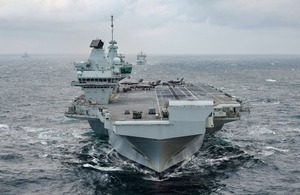Royal Navy aircraft carrier in final preparation to lead multinational deployment to Mediterranean and Indo-Pacific
Nearly 4,000 British personnel will support the deployment, which will deliver trade events in Singapore, Japan, and India, promoting Britain鈥檚 world-leading industry

HMS Prince of Wales
Final preparations are underway for a multinational deployment, led by the Royal Navy flagship HMS Prince of Wales, reaffirming the UK鈥檚 commitment to the security of the Mediterranean and Indo-Pacific, while providing an opportunity to promote British trade and industry.
Aircraft carrier HMS Prince of Wales is scheduled to sail from Portsmouth on 22 April, where it will proceed to join a formation of warships, supply ships, and aircraft off the coast of Cornwall, before departing for the Mediterranean where it will conduct exercises to reinforce European security.
Around 2,500 personnel from the Royal Navy and 592 from the Royal Air Force will be involved in the eight-month deployment, which will see the group sail through the Indian Ocean to conduct exercises and port visits with partners including the US, India, Singapore, and Malaysia. They will be joined by around 900 personnel from the British Army for exercises during the deployment.
The deployment, named Operation Highmast, provides an opportunity for the UK鈥檚 Armed Forces to conduct a major global deployment and a chance to exercise complex operations alongside partners and allies in the region, with 12 other nations supporting the deployment with ships or personnel.
The Indo-Pacific is a critical region for UK trade, with imports and exports in the region worth billions of pounds for the UK economy, and the deployment will provide a chance for UK companies to take part in trade events during port visits.
Trade between the UK and Indo-Pacific accounted for 17% of total trade between the UK and all trading partners in the 12 months to September 2024, with the total amount traded in goods and services between the UK and Indo-Pacific standing at 拢286 billion in the same period.
As the biggest class of ship in the Royal Navy, the flight decks of HMS Prince of Wales and her sister ship are roughly the size of three football pitches and defended by advanced weapons. A maritime strike force of this size is composed of multiple types of ship, frigates, destroyers, submarines, and supply ships to support logistics.
Defence Secretary, John Healey MP, said:
I want to thank the thousands of our Armed Forces personnel involved in the delivery of this immensely complex operation, demonstrating the UK鈥檚 world-leading capability to deploy a major military force around the world.
This is a unique opportunity for the UK to operate in close coordination with our partners and allies in a deployment that not only shows our commitment to security and stability, but also provides an opportunity to bolster our own economy and boost British trade and exports.
As one of only a handful of countries in the world able to lead a deployment of this scale, the Royal Navy is once again demonstrating its formidable capability while protecting British values and sending a powerful message of deterrence to any adversary.
Of the 12 other nations supporting the deployment, Norway will provide a warship to support the carrier strike group for the entire duration of the deployment. Canada and Spain are among the other nations providing support to the deployment.
After its complement of up to 24 Royal Air Force F-35B Lightning fighter jets is embarked on board HMS Prince of Wales, and the departure for the Mediterranean, the group will initially be placed under NATO command as it joins Exercise Neptune Strike 鈥� testing the Alliance鈥檚 ability to use high-end maritime strike capabilities, including multiple aircraft carrier and amphibious strike groups.
The group will transit though the Indian Ocean, conducting exercises and port visits with partners including the US, India, Singapore and Malaysia, before joining 19 partner nations for Exercise Talisman Sabre near Australia, and then training alongside the Japanese Self Defence Forces and conducting a port visit to India.
Minister for the Armed Forces, Luke Pollard MP, said:
Through this deployment of our Carrier Strike Group and 4,000 Service Personnel, we will stand firm with our allies against those who challenge the international order. Reminding the world that the security of the Euro Atlantic and Indo-Pacific are fundamentally indivisible.
This isn鈥檛 just about hard power; it鈥檚 about building influence and opening new trade opportunities both for defence and other sectors of our economy which will deliver British jobs and growth.
This deployment follows the Prime Minister鈥檚 historic commitment to increase defence spending to 2.5% of GDP, demonstrating this Government鈥檚 commitment to keep the UK secure at home and strong abroad.
Following the inaugural deployment in 2021, the Carrier Strike Group 2025 highlights the strength of the UK鈥檚 leadership in seeking to uphold stability in the Indo-Pacific. This has been bolstered by the Royal Navy鈥檚 persistent presence in the region through HMS Spey and HMS Tamar, as well as the landmark Global Combat Air Programme collaboration.聽
Keeping the country safe is the Government鈥檚 first priority and is the foundation of its Plan for Change. The strength, capability and global reach of the Royal Navy, British Army and Royal Air Force, demonstrated through Operation Highmast, is critical to the security and stability of the UK, supporting the delivery of the Government鈥檚 five missions.